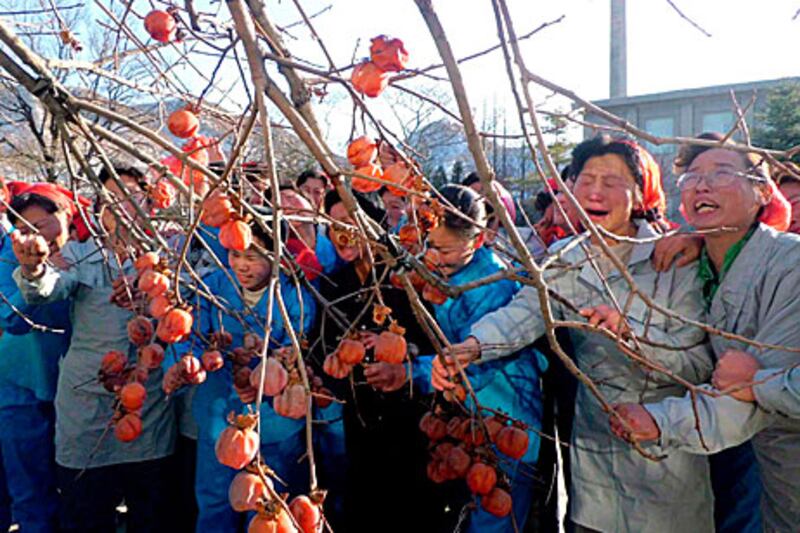BEIJING // North Korea will lay its late leader, Kim Jong-il, to rest today in a ceremony that will attempt to stoke feelings of love and loyalty for his youngest son and heir.
Kim Jong-il's farewell ceremony is widely expected to mirror the only state funeral the country has ever held, that of his father and North Korea's founder, Kim Il-sung, in 1994.
The rituals following Kim Il-sung's death - including lying in state for 10 days - were thought to be based on Korean traditions, but according to Kim Jong-il's official biography they were largely created and choreographed by the new heir to maximise his father's legacy and thus his own power.
Now Kim Jong-il's son, Kim Jung-un, is expected to try to convey the same sense of legacy as command of the secretive communist state passes to the third generation of the same family.
"The form and content of 1994 will be emulated," said Song Ji-young, an expert on North Korea at Singapore's National University.
"The funeral will be used to show that Kim Jong-un is no newly created leader, but that he inherits his words and legacy of the nation's father through the passing of his own father," she said.
Kim Jong-un, who is thought to be 29, was barely known in or out of North Korea when his father death of a heart attack on December 17 was announced. Since then the state media has done its best to raise his profile by ascribing feats of bravery - including the "thrashing" of 70 American soldiers - and new epithets to him, but his father's funeral remains the single most important rite of passage.
"It marks the beginning of his leadership. After this we will really start to see him consolidate his power and authority," said Ryoo Khil-jae at the University of North Korean studies in Seoul.
North Korea analysts will also be watching the funeral for signs of who might exert influence on the young leader once the period of mourning ends.
To many observers' surprise the transition of power has gone smoothly, but Kim Jong-un has almost no political experience and he will have to rely on a team of veteran political players and military figures to rule the country.
His uncle Jang Song-thaek is widely thought to be the power behind the throne but North Korea observers will also be looking to see how prominent a role the military plays as an indicator of how strictly Kim Jong-un will adhere to his father's policy of "songun", or "military first" - a policy his uncle is thought not to agree with.
Thus far the army and Kim Jong-un's family seem to be united behind the new leader, with his uncle - who is on the National Defence Commission but has never served in the army - donning a general's uniform this weekend, a move that was interpreted by some analysts as a show of support for the military.
Experts also say the authorities in North Korea will be very sensitive to comparisons with Kim Il-sung's funeral in 1994. Then, tens of thousands of wailing mourners lined the streets of Pyongyang, to watch his transparent coffin, bedecked with red flag and white magnolias, drive past on top of his presidential car.
Observers say that despite the freezing temperatures in Pyongyang at this time of year - Kim Il-sung died in the summer - a large number of mourners will be mobilised to give the impression that the Kim dynasty is still legitimate.
North Korea's state media have been silent of the exact timing and plans for the funeral saying only that it will end tomorrow with "mourning shots" being fired in Pyongyang and the nation observing three minutes of silence.
Based on the 1994 funeral, the South Korean media predicted it would start at 10am with Kim Jong-un and senior officials paying final respects at the memorial palace.
They said the military was expected to fire a 24-gun salute and troops would march through central Pyongyang, accompanying a limousine carrying Kim Jong-il's coffin and another car with a giant photo surrounded Kimjongilia - a type of begonia named after the "Dear Leader".
"There may even be a small-scale military parade involving aeroplanes," said Ahn Chan-il of the World Institute for North Korea Studies in South Korea.
But while thousands may turn out today to say their final farewell to their leader of 17 years it may only be a matter of months until they have the chance to see him again.
If Kim Jong-il's funeral does follow the same form as his father's, there is a good chance that he will also be embalmed and put on display in the Kumsusan mausoleum in downtown Pyongyang.
One of the Russian specialists who travelled to Pyongyang in 1994 this week gave an interview to a Russian newspaper that hinted they might be called again.
"I remember that when Kim Il-sung died, there were reports that he had been buried," Pavel Fomenko told Moskovsky Komsomolets. "But at the same time they were asking us to prepare our products and some days later we took off for Pyongyang."





